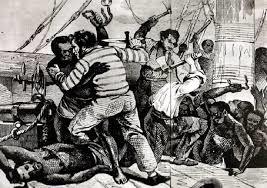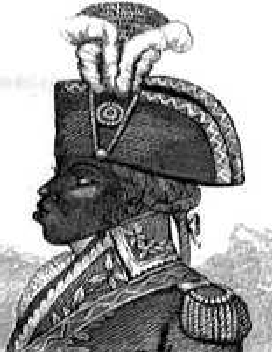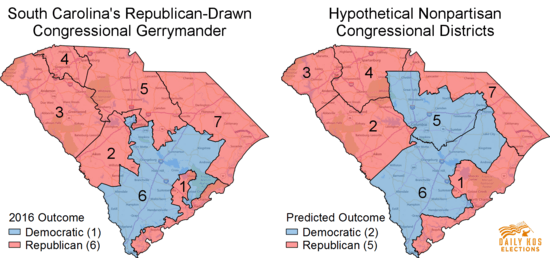Black Caesar’s Rise From Enslaved African Warrior Chief to Pirate of the Caribbean — by dopper0189, Black Kos Managing Editor
Black Caesar (place date of birth unknown — died 1718) was a legendary 18th-century Caribbean pirate of West African decent. For nearly a decade, he raided ships from the his home base in the Florida Keys and later served as one of the infamous pirate Captain Blackbeard‘s (Edward Teach’s) head crewmen aboard the Queen Anne’s Revenge. Caesar was one of the few surviving members of Blackbeard’s crew following his death at the hands of Lieutenant Robert Maynard in 1718. Caesar’s Rock, one of three islands located north of Key Largo, is named in his honor, and is the site of Caesar’s original headquarters.

I first heard of Black Caesar when I was a child, after meeting an older relative who named his large dog Caesar (actually it was a HUGE dog). I had at first assumed he named the dog after Julius Caesar the Roman Emperor, one of my cousins later corrected me and told me he was named after Black Caesar the pirate. Years later in college I got into a discussion with some black friends about the blaxploitation flick Black Caesar, they didn’t know the name had come from the pirate so I looked him up and showed them.
During the ”golden age” of piracy in the late 1600s and early 1700s, a pirate ship was one of the few places a black man could attain power and money in the Western Hemisphere. Some of these black pirates were fugitive slaves in the Caribbean or other coastal areas of the Americas. Others joined pirate crews when their slave ships or plantations were raided; it was often an easy choice between perpetual slavery and freedom through piracy.
Historians estimate that approximately 1/3 of the 10,000 pirates during the golden age of piracy were former slaves. While many were still mistreated and forced to do the lowest tasks aboard ship, some captains established revolutionary equality among their men, regardless of race. On these ships, black pirates could vote, bear arms, and receive an equal share of the booty. However back on dry, justice for black and white pirates was not equal. White pirates were usually hanged, but black pirates were often returned to their owners or otherwise resold into slavery, a fate often worse than death.

The most famous black pirate was of course Black Caesar, who raided ships in the for almost a decade before joining Blackbeard aboard the Queen Anne’s Revenge. Like many pirates, his life is shrouded in legend, but he was apparently a very large and very cunning man. Before enslavement Black Caesar, according to traditional accounts, was a prominent West African tribal war chieftain. Caesar was widely renowned for his “huge size, immense strength and keen intelligence,” and had evaded capture from many different slave traders, until he was finally captured by a cruel deception.
Caesar was captured in West Africa when he and twenty of his warriors were lured onto a ship by a slaver posing as a trader in goods. The “trader” showed him a watch, and then promised to show Caesar and his warriors more objects. The slaver then claimed the goods were “too heavy and too numerous to bring on shore” but if they came aboard his ship he’d display them all. The slaver then enticed Caesar and his men to stay aboard with food, musical instruments, silk scarves, and jewels. But while doing this the slave-trader had his men secretly raise anchor and slowly sail away.
When the Caesar discovered what was happening, alarmed he and his men attempted to charge their captors but were driven back by the well-armed sailors using swords and pistols, and imprisoned. Although it took a considerable length of time for him and his warriors to accept their captivity, he was eventually befriended by a sailor who was the only man Black Caesar would accept food and water from. Unlikely as it seems aboard a slave ship, the sailor who gave him food and water and Caesar became close friends. It seems the sailor was an indentured servant who wasn’t happy with his own lot in life.

Later on the journey as they neared the Florida coast, the sudden appearance of a hurricane threatened to destroy the ship on the Floridian reefs. Recognizing the ship’s imminent destruction, the indentured servant sailor snuck below the deck and freed Caesar. The hurricane had provided all the confusion the Caesar and his new friend needed for an escape. The sailor and a few surviving members of Caesar’s African warriors forced the captain and crew into a corner at gunpoint. The men then loaded one of the longboats with ammunition and other supplies. The wind and waves pushed them to shore where they waited out the storm. But apparently between the storm and slave uprising, only Caesar and his one sailor friend survived the conflict on the doomed ship.
For several years thereafter, the pair amassed a considerable fortune by posing as shipwrecked sailors. They began by using the lifeboat from the doomed slave ship to lure passing ships which stopped to give assistance. While posing as the shipwrecked sailors, they would sail out to the vessel offering to take them aboard. Once they were close to the vessel, they brought out their guns and demanded supplies and ammunition, threatening to sink the ship if they were refused.

Caesar and the sailor continued this ploy for a number of years and amassed a sizable amount of treasure which was buried on Elliott Key. However, he and the sailor had a falling out over a young woman the mate had brought back from one of the ships they had looted. Fighting over her, Caesar killed his longtime friend in a duel and took the woman for his own.
Over the next decade Caesar began taking on more pirates, and over time was soon able to attack ships on the open sea. He and his crew were often able to avoid capture by running into Caesar Creek and other inlets between Elliot and Old Rhodes Key and onto the mangrove islands. Using a metal ring embedded in a rock, they ran a strong rope through the ring, heeled the boat over, and hid their boat in the water until the patrol ship or some other danger sailed away. Caesar also lowered the mast and sunk the ship in shallow waters, only to later cut the rope and pump out the water to raise the boat and continue raiding. It is thought that he and his men buried 26 bars of silver on the island, although no treasure has ever been recovered from the island.
Caesar apparently had a harem on his island, having several women seized from passing ships, as well as a prison camp which he kept prisoners in stone huts hoping to ransom them. When leaving the island to go on raids, he left no provisions for these prisoners and many eventually starved to death. A few children reportedly escaped captivity, subsisting on berries and shellfish, and formed their own language and customs. This society of lost children gave rise to native superstition that the island is haunted.
.
During the early 18th century, Caesar left Biscayne Bay to join Blackbeard in raiding American shipping in the Mid-Atlantic serving as a lieutenant on his flagship Queen Anne’s Revenge. In 1718, after Blackbeard’s death battling with Lieutenant Robert Maynard at Ocracoke Island, Caesar attempted to set off the powder magazine as per Blackbeard’s instructions. However, Caesar was stopped by one of the captives who tackled him as he prepared to light a trail of gunpowder leading to the magazine. He struggled with the man below decks until several of Maynard’s sailors were able to restrain him. Taken prisoner by the Virginian colonial authorities, Caesar was convicted of piracy and hanged in Williamsburg, Virginia as he said he would never live as a slave.
But historian Cindy Vallar contest this story, she claims that the Black Caesar who was part of Blackbeard’s crew was in fact not the same man as the Black Caesar who operated in the Florida Keys. Vallar notes that the former was actually a slave owned by a Tobias Knight of North Carolina before he became a pirate. Thus, it is possible that there were two Black Caesars and that their stories were conflated, in which case the ultimate fate of the Florida Keys Black Caesar is perhaps lost to history.
Later adding to the confusion over the name during the Haitian fight for independence a slave name Henry took up the moniker Black Caesar.

Henri Caesar was born a slave on the island and as a young man worked in a lumber yard. The supervisor of the yard mistreated him and Henri saw a chance for freedom during the slave insurrection toward the end of the 18th century. During the insurrection, he killed the supervisor and joined the underground freedom fighters.
Caesar stayed on the island until it received independence from France, then set off to make his fortune at sea. According to the tale, he captured a Spanish ship and made his way around Cuba and the Bahamas. By 1805, under the name Black Caesar, he was attacking small villages and lone ships from his base in the Florida Keys.
Henri Caesar is said to have buried between $2 million and $6 million in treasure across several islands in the area. He disappeared around 1830 with various theories as to why. Some say that he fled when the US took possession of the area, while others believe that he was captured and burned to death by the US authorities.
Sources
~~~~~~~~~~~~~~~~~~~~~~~~~~~~~~~~~~~~~~~~~~~~
News round up by dopper0189, Black Kos Managing Editor
~~~~~~~~~~~~~~~~~~~~~~~~~~~~~~~~~~~~~~~~~~~~~~
~~~~~~~~~~~~~~~~~~~~~~~~~~~~~~~~~~~~~~~~~~~~~~~~~~~~~~~~~~~~~

The justices may have stepped away from their unrelenting hostility toward voting rights plaintiffs. Vox: The high stakes in a new Supreme Court showdown over gerrymandering
~~~~~~~~~~~~~~~~~~~~~~~~~~~~~~~~~~~~~~~~~~~~~~~~~~~~~~~~~~~~~
On October 11, the Supreme Court will hear a challenge to racially gerrymandered congressional maps in South Carolina that could tell us a lot about where the Court stands on voting rights.
The lower court in this case, known as Alexander v. South Carolina State Conference of the NAACP, determined that the state’s Republican legislature excluded Black voters from the state’s First Congressional District in order to shore up Republican control of that district.
The stakes in any congressional gerrymandering case are high because these cases can potentially impact who will control the US House of Representatives in the future. And the Court’s ultimate decision in Alexander may be unusually significant.
For years, the Supreme Court’s Republican majority had been almost unrelentingly hostile toward voting rights plaintiffs, and especially toward the Voting Rights Act — a federal law that bans race discrimination in elections. But in a surprising move last June, the Court struck down an Alabama gerrymander, affirming a lower court decision holding that the state violated the Voting Rights Act when it drew congressional maps that diluted Black voting power within that state.
Notably, the Court’s 5-4 decision in that case, known as Allen v. Milligan (2023), was written by Chief Justice John Roberts, and it rested upon a provision of the Voting Rights Act that Roberts unsuccessfully pushed President Ronald Reagan to veto when he was a young political appointee in the Justice Department.
So Milligan is potentially the first sign that the Court’s hostility toward voting rights plaintiffs is diminishing. Now, with Alexander, the first major voting rights case the Court has taken up since, we could see how committed to that pivot the justices actually are.
Technically, the legal issue in Alexander is distinct from the one in Milligan. Milligan held that Alabama violated the Voting Rights Act when it drew its congressional maps, while the lower court in Alexander held that South Carolina violated the Constitution’s safeguards against race discrimination, which function quite differently in racial gerrymandering cases.

~~~~~~~~~~~~~~~~~~~~~~~~~~~~~~~~~~~~~~~~~~~~~~~~~~~~~~~~~~~~~
The map will likely add a Black — and Democratic — member to the delegation. Politico: Court picks new Alabama congressional map that will likely flip one seat to Democrats
~~~~~~~~~~~~~~~~~~~~~~~~~~~~~~~~~~~~~~~~~~~~~~~~~~~~~~~~~~~~~
A federal court has picked Alabama’s new congressional map, which will likely result in an additional Black — and Democratic — member in the delegation.
The new map came after the same panel of federal judges twice found that lines drawn by the GOP-dominated Legislature likely violated the Voting Rights Act by weakening the power of Black voters. The new lines will be used for at least the 2024 elections, the state’s Republican secretary of state said on Thursday, though Alabama Republicans have vowed to fight them for future cycles.
The map gives greater electoral power to Black residents, who make up about one-quarter of the state’s population. And it will very likely mean Republicans lose one seat in their thin majority, imperiling their already tenuous hold on the lower chamber even before battleground districts come into play.
“With this new, fairer map, and for the first time ever, Black voters in Alabama could have two members of Congress representing their interests at the same time,” Eric Holder, the former Democratic attorney general who now helms the party’s redistricting arm, said in a statement. Holder’s organization was involved in the lawsuit that ultimately brought about the new maps.

~~~~~~~~~~~~~~~~~~~~~~~~~~~~~~~~~~~~~~~~~~~~~~~~~~~~~~~~~~~~~

This year has had more setbacks than progress—but the fight for equity has always required patience. Bloomberg: The Fight for Equality in 2023 Is a Very Long Game
~~~~~~~~~~~~~~~~~~~~~~~~~~~~~~~~~~~~~~~~~~~~~~~~~~~~~~~~~~~~~
In 2016, Facebook released a diversity report revealing that the company’s employees were 90% White and Asian, and 67% male. Then it blamed the American public school system for making it that way.
“Appropriate representation,” Maxine Williams, Facebook’s head of diversity, said at the time, “will depend upon more people having the opportunity to gain necessary skills through the public education system.” She went on to lament how few women and minorities take the Advanced Placement exam in computer science. In other words, Facebook didn’t have many Black or Latino employees, because they didn’t take the right high school classes.
Four years later, in the wake of the 2020 Black Lives Matter protests, Facebook joined dozens of other major companies in publicly committing to hiring more people of color. Then, surprisingly, it did: By 2021 the company, newly renamed Meta, had hired more than 650 Black workers, including managers and executives. It was a significant if modest gain: Overall, less than 5% of Meta employees are Black, but that’s more than double what it was back in 2016.
It wasn’t the only company to make progress. According to a Bloomberg analysis of S&P 100 employment data representing 9 million people, of all the jobs created in 2021, 94% went to people of color. The problem wasn’t the public school system after all. All companies had to do was make an effort.
Most of the time, progress doesn’t happen this quickly. In this year’s Equality Issue are stories of people fighting for change over long periods. The Chagos people have been petitioning the British government for the right to return to their island homeland for more than 50 years. For decades, women in the US have pushed to overhaul an unforgiving child-care industry that’s about to get much worse. Native Americans in the Southwest are trying to root out rampant fraud and forgery in the Indigenous art market. Companies that have supported Pride for years continue to experience conservative backlash. It’s taken more than 30 years for Tyler Perry to build his own version of Black Hollywood, in Atlanta, yet he’s still yearning for respect.

~~~~~~~~~~~~~~~~~~~~~~~~~~~~~~~~~~~~~~~~~~~~~~~~~~~~~~~~~~~~~

Some say the facilities, which focus on autonomy in childbirth, could lead to better health outcomes — but officials are tightening rules, citing risk. New York Times: For Black Mothers, Birthing Centers, Once a Refuge, Become a Battleground
~~~~~~~~~~~~~~~~~~~~~~~~~~~~~~~~~~~~~~~~~~~~~~~~~~~~~~~~~~~~~
Gabrielle Glaze felt scolded and shamed when she delivered her first son in a Birmingham, Ala., hospital, forced to observe strict rules about lying stationary through her contractions and enduring countless cervical checks from “total strangers” who seemed disappointed by her body’s progress.
So when Ms Glaze, 33, gave birth to a second son in a birthing center in April, surrounded by a team of midwives who said they would let her body lead the way, it seemed as if her previous labor experience had finally been redeemed.
Ms. Glaze found herself telling every woman she knew about Oasis Family Birthing Center in Birmingham, which was run by an obstetrician and midwives — many of Black, like her — and encouraged patients through and unhurried, uninterrupted, natural labor process. She said it seemed like the answer to centuries of birthing trauma among Black women, providing medical expertise in a a culturally familiar space, with the hope of improving both birthing experiences and health outcomes for woman of color.
But Ms. Glaze was one of the last woman to deliver at the facility. In June, the Alabama Department of Public Health shut it down, despite its record of smooth deliveries with no complications. State regulators are now weeks away from instituting new birth licensing rules that would make it nearly impossible for similar facilities to open and operate.
“If these rules are not implemented, there will be fewer safeguards and standards for the operation of these facilities, exposing mothers and their newborns to increasing risk to their health and safety”, a public drafty of the new policy says.
Oasis and two other birth centers seeking to operate have sued the state with the help of the A.C.L.U., seeking to overturn the closure and create a path for others to open.

~~~~~~~~~~~~~~~~~~~~~~~~~~~~~~~~~~~~~~~~~~~~~~~~~~~~~~~~~~~~
~~~~~~~~~~~~~~~~~~~~~~~~~~~~~~~~~~~~~~~~~~~~~~~~~~~~~~~~~~~~~
~~~~~~~~~~~~~~~~~~~~~~~~~~~~~~~~~~~~~~~~~~~~~~~~~~~~~~~~~~~~~~~~~~~




